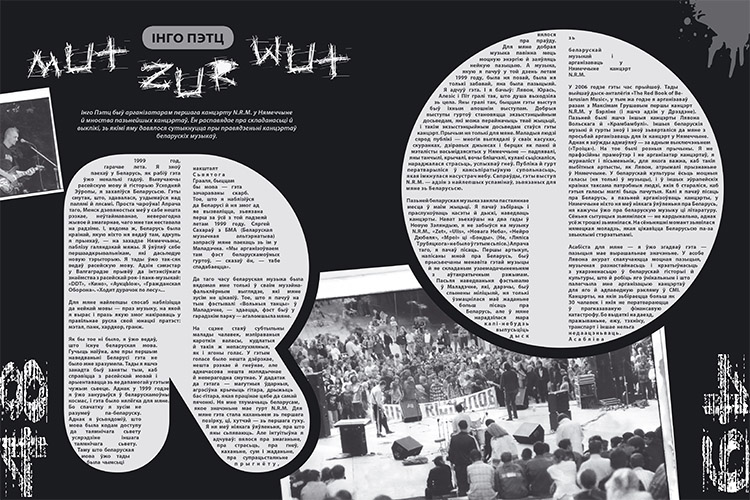
Аўтар: Tania Arcimović, 23/07/2014 | THEATRE topical
HATKA: TO FIND YOUR INSIDE
pARTisan #26’2014
In September 2013 Uladzimir Śćerbań (Vladimir Shcherban), director of Belarus Free Theatre, mentioned very briefly in his blog after a long line of reasoning that the premises in which they had lived and worked for almost six years, better known as hatka (Note: «hatka» in the Belarusian language means «a small house»), no longer belonged to them. The authorities invited the owner of the house for a talk and advised to refuse Belarus Free Theatre a shelter if he ever wanted to run his business without problems.
That’s how a very important period in the theatrical (and not only) life of the Belarusian capital came to an end, both for the theatre and its viewers.
It was by far the only island of free theatrical statement in Minsk; a place where one could hear opinions that were only discussed on forums or in private, meet people whose courage inspired over and over again. The amateurs of Belarus Free Theatre took a deep breath and paused: whatever happened, the Free Theatre must perform in homeland.
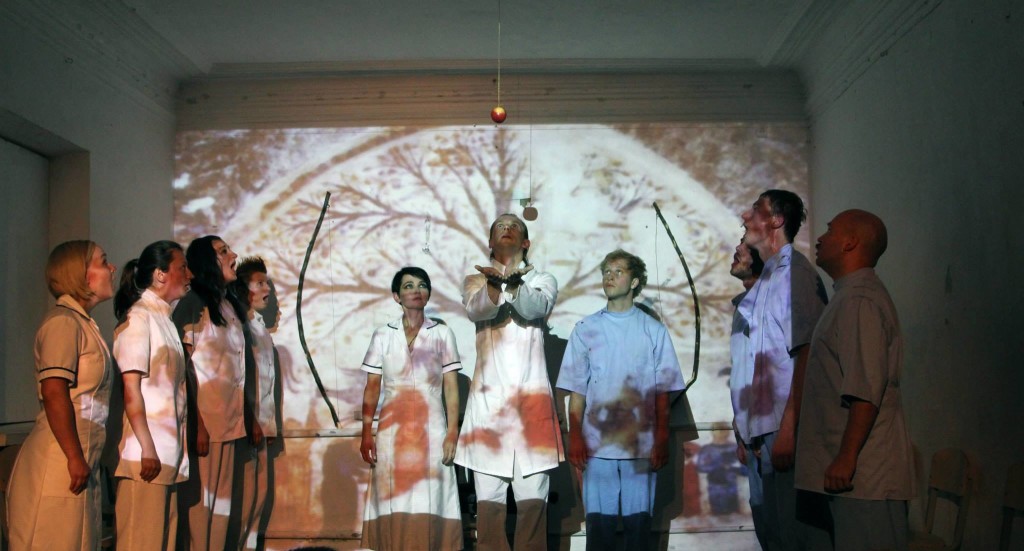
Happy New Year, Ms Midous, dir. Uladzimir Śćerbań / 2013 photo by BFT
My personal experience of hatka began much later than it had appeared on the map of Minsk. I had seen several performances by the Free Theatre at other stages. But I have always heard about this place enchanted with myths and legends. Once I came there myself.
According to Uladzimir Śćerbań, the first journey to hatkafor many people really becamethe «road of discovery. I think it was a good idea. For us it was rather a necessity, but in the end it worked. The viewer had to find hatka. A rare taxi driver knew how to get here, though it was almost in the center of Minsk. Anyway, these obstacles revealed a desire: if one really wanted to find it, they would». Ten minutes before the start of the performance the audience gathered at the restaurant «Apple», and many thought that it was there that the play would be staged. Then a stalker came up, and took the newcomers along a rural street to the area with private houses beginning right after the restaurant. Surely, the tension grew.
«Until the last moment most people thought that they must have been taken to the big blue house, which we had seen being built. Often, the late comers headed straight there. No one would have thought that a world famous theatre found a shelter in a one-storied wooden building nearby.
Actually, the same thing happened to me. I really thought that the huge blue house was a theatre. Well, there was a small house near it, but it was hard to imagine that it could seat such a crowd of people.
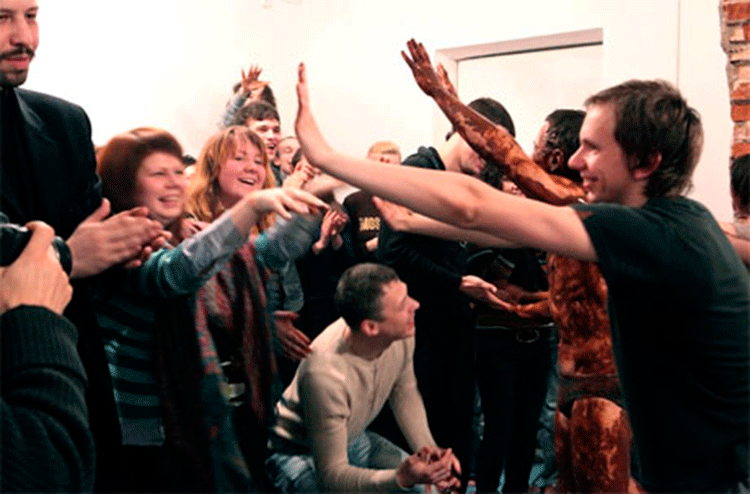
Flower for Pina Bausch, dir. Uladzimir Śćerbań / 2008 photo by BFT
However, first time I went there without a guide. After I had approached the «Apple», I saw several people and I could read in their faces that we were getting to the same place. But several people who I had noticed in the bus and intuitively felt that were getting to the same place, did not stop and went on. I followed them. It is interesting but the process of waiting near the restaurant or going on a bus was always silent, even if one had already guessed that they were «the same blood».
The audience of the Free Theatre recognized each other by their clothes, by special gestures, but mainly, by the presence of something «different» in their eyes.
This silent recognition of being «one of us» is another important discovery on the way to hatka, on the way to the expectation of the start when the viewers were crowding at the stairs and then went searching for their seats and the finale. If you came alone, and that’s how most people did, you looked into each other’s eyes again as if trying to compare the intensity of your own emotions.Strangely, there was no need for a unique experience; on the contrary, there was a need for something common that would allow surviving in the swirl inside. But you looked down instead, and silently walked back along the road full of lonely shadows.
***
The history of hatkabegan in 2007, when the Free Theatre was banned on other alternative platforms of the city. At that time Uladzimir Śćerbań was doing one performance after another, the troupe hadalready changed a lot of places. «First there was a club «Graffiti»;Psychosis4.48 by Sarah Kane was played there a few times. After a long time of searching for a place – we had asked many clubs by then and the answer was a «no» – this was a gift. «Graffiti» was followed by the club «68» where the theatre also staged several plays. The premiere of Being Harold Pinter was performed at a friend’s cottage outside the city (twice)». Clearly, the theatre needed its own place in the city. All of a sudden, the musician Laur Berźanin found a hatka.
For many years this place has been a real home, this is what everyone says when asked about hatka.
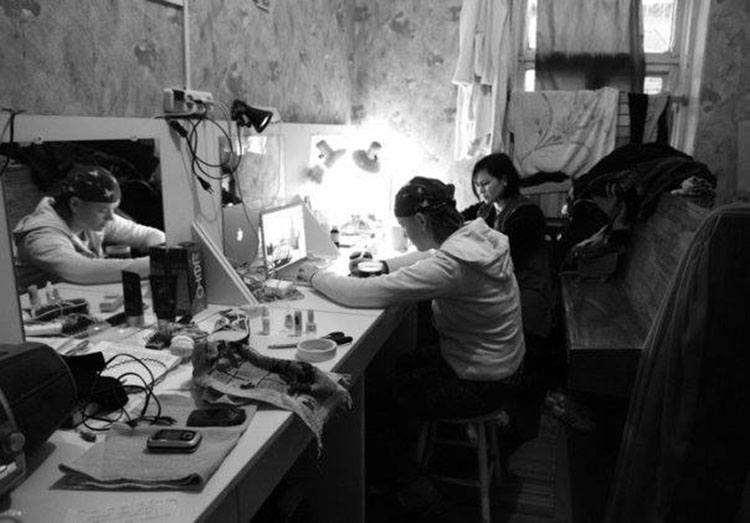
A dressing room / photo by N.Khalezin
It was an ordinary wooden house with two rooms. The wall between them was demolished at once, with parts of brick left thus forming a conditional stage. There were windows which they soon learnt to drape with white paper. It was cold inside. Śćerban remembers that when he was staging there his first play Legends of the Childhood (the first part of the trilogy Silent Zone) he even caught a rash, a typical children’s disease as the doctor said. The place was getting more lived in; the space was getting familiar opening its unrealistic possibilities: it turned out to be very flexible. The viewer could be seated in any place depending on the director’s creative idea. The viewers became as insecure as the actors who lived at an arm’s length to the first row of the theatre hall. Some people were clearly worried by such closeness, because there was no darkness typical for the theatre, in which one could hide during the performance. The plays were performed in the regular lighting, sometimes lit by lanterns or just a bulb.
Such openness to the viewer also became a significant experience: under such circumstances it was impossible to remain avoyeur. One would have to be an active accomplice of what was happening before their eyes.
Uladzimir Śćerban: «It was a sincere place. I truly believe that the place where a play is staged dictates the modality. I don’t like aggregate theatrical space where everything is specially adjusted to provide comfortable work, where everything’s functioning. But you don’t understand what country it is. Hatka had the atmosphere and intimacy typical of a lived-in home. There we staged Silent Zone, A Flower for Pina Bausch, New York’79 by Kate Acker, Nearest and Dearest by Koscia Sciećyk — all these plays became very sincere and personal. Though, the American, I mean, Acker boldly rushed into this space, it had a different voice. Still, all the other works were about those ones who lived and worked in this house».
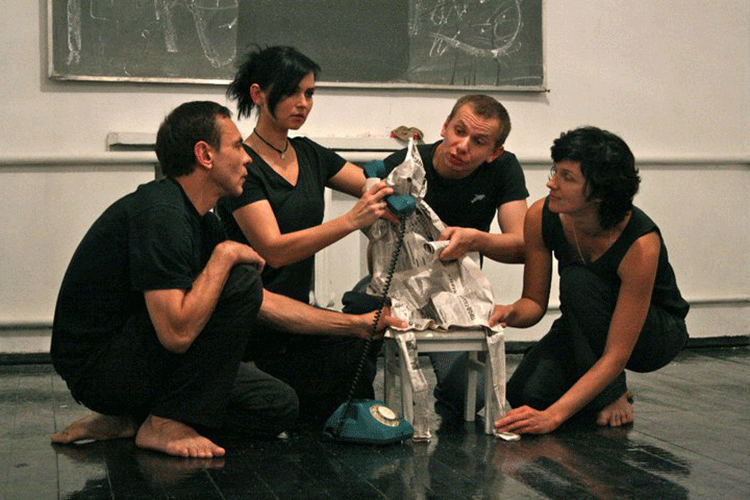
Childhood’s legends, dir. Uladzimir Śćerbań / 2008 photo by BFT
Qualitative capacity of hatka was very surprising every time: there were only 50 seats, but there were so many willing to attend those additional rows were built up. All of a sudden, this limited space could seat seventy, eighty, or even more people (the viewers sat closer to one another with their legs tucked up beneath). The theatre was attended by famous people from all over the worlds, such as Tom Stoppard, Mark Ravenhill, selectors of the world famous theatre festivals. Among the attendees were not only theatre amateurs, but also journalists for whom it was a first theatre experience.
Many foreign guests thought that the troupe deliberately chose such a half-underground aesthetics (everything suited the status of the «forbidden theatre» starting from the moment of signing up for the performance to the meeting at «Apple» to be taken to the cramped room of hatka). Unfortunately, it wasn’t a choice. It was a necessity, an only possibility for the troupe to stage their plays.
Uladzimir Śćerban:«I know that many were wild about putting plastic bags on top of their shoes as if they had been at a museum or church. But it was a technical necessity. Many were shocked. Before the performance I used to ask the audience who was there for the first time. But before they could answer I had already known: it could have easily been guessed by the look their clothes. Everything was clear if a girl in a short skirt and high-heeled shoes was sitting on the floor with a stiffen face, her legs bent – she had been going to the theatre. When the same girl came next time wearing jeans and trainers, it was clear that it was a purposed visit. The intimacy of hatka allowed studying everyone, it was a family meeting. It was interesting to observe how at first the viewers came in glitz style, and afterwards dressed simply to be able to comfortably bend their legs».
When asked about the brightest memory of hatka, the troupe saysin one voice that these were cockroaches. Fight against them was an eternal problem for the theatre. Definitely, in winter the old house and the cockroaches reminded of themselves more actively. Little did the audience know how the actors worried from time to time that a cockroach might have appeared on the stage during the performance.
Uladzimir Śćerban: «They used to eat up all properties, soup. We couldn’t exterminate them, because it would have began to smell. I remember once a cockroach got drowned in the loo. One of the girls found it and began to scream. A mystifying picture – a dead cockroach swimming in water. Then Aliośa Śyrniević came and pulled it out. Maybe this was why the image of a cockroach often appeared on our plays?»
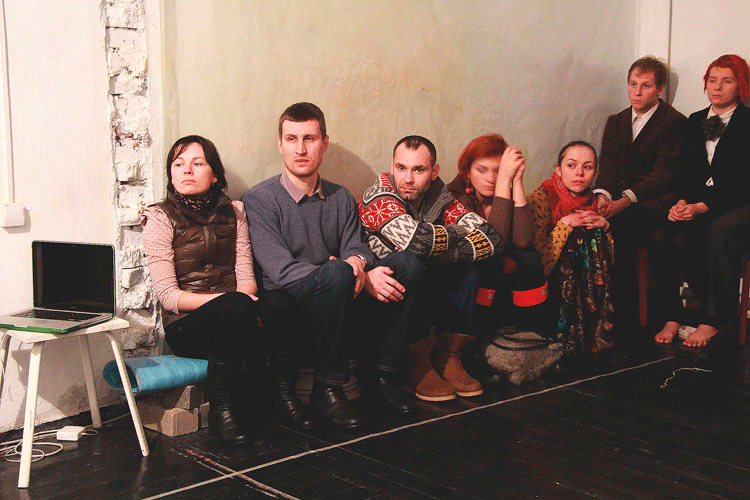
One’s people, dir. Uladzimir Śćerbań / 2008 photo by pARTisan
***
There used to come many guests including those who had, in fact, been expected but not wanted to be seen. Every time we had to worry if the performance would go smoothly, would not be interrupted in the middle requesting the viewers to show their passports. A kind of a mental schizophrenia. Such things also happened. For a film director a deranged play is an unspoken pain, as if being cut alive. Sometimes it was a lull, sometimes the relationships were strained. But it was clear from the very beginning that everything was under control.
It is not clear why exactly this autumn after almost six years it has been decided to close hatka down. There haven’t been any official complaints from the neighbours. Neighbours as if didn’t exist at all: the blue house nearby indifferently looked at hatka with its silent windows. It is surprising that the news that the Free Theatre lost hatka passed silently. Maybe not to do harm? Or, maybe because everyone believed that the solution would be found. The theatre is only alive when it plays on stage. Otherwise, it doesn’t exist. The Free Theatre must exist here. It actually happened this way: in a few months the troupe played several plays and a premiere New Year Tree at the Ivanovs by Alexandr Vvedensky at other platforms in the city, basically for the first time in many years the Free Theatre sounded outside hatka which only remained in memories. This place seems to be connected not just with the story of one theatre only.
Hatka was an image and symbol of the country with cold,frost, mental schizophrenia, and rats: a test which, if able to stand, will enable to find your inside.
***
Uladzimir Shcherban: «Whyhatka? No onehasinventeditonpurpose, itwasabsolutelyrational. Anickname. It’snotahousebynomeans. IalwaysfeltuneasywhenIread«inaprivatehouse».Howcomeitwasahouse? It’s a hatka! Therewasawonderfulinhabitant – theowner’sfather. He looked after the house, brought various different stuff, which we then used as props. He did not see any of our performance, even when the real problems began − Special Forces of police arrested us. Or maybe he was more comfortable that way? He thought that there were parties. However, once we invited him to A Flower for Pina Bausch. I did not know how he would react. But he liked it; he even said he certainly would like to act at our theatre…
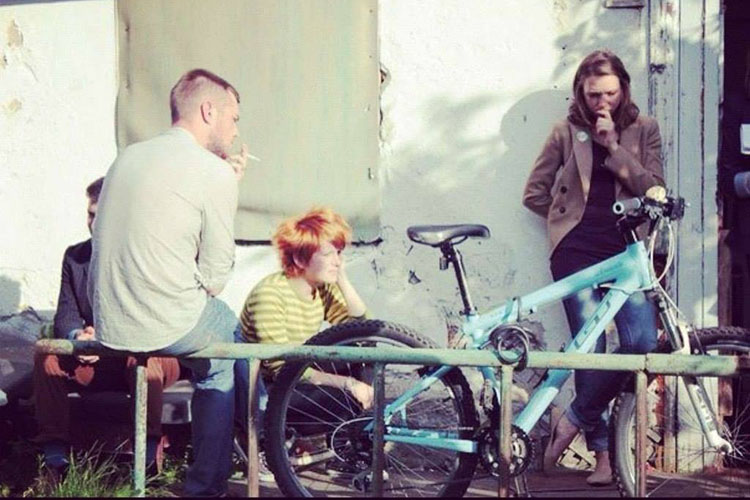
Close by hatka / photo by BFT
Hatka is the right name. We have lived here for many years, grown and matured, lots of things have happened to each of us. And all of these periods we have lived together. If there is nothing, we cling to the space. So we did. Now a new page again, we have again become travelers. But perhaps this is how it should be to stay alive.
Tania Arcimović, 2013
Opinions of authors do not always reflect the views of pARTisan. If you note any errors, please contact us right away.




